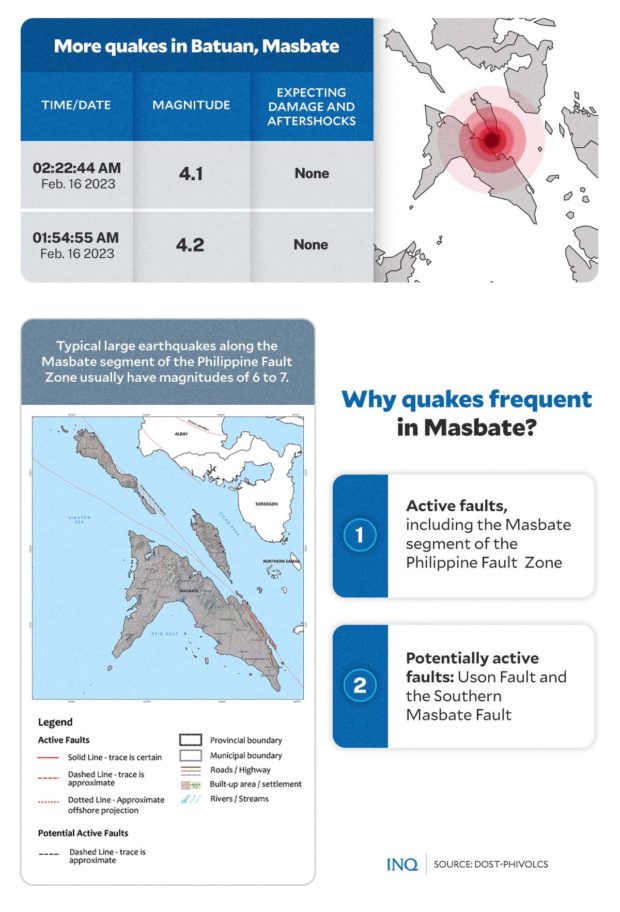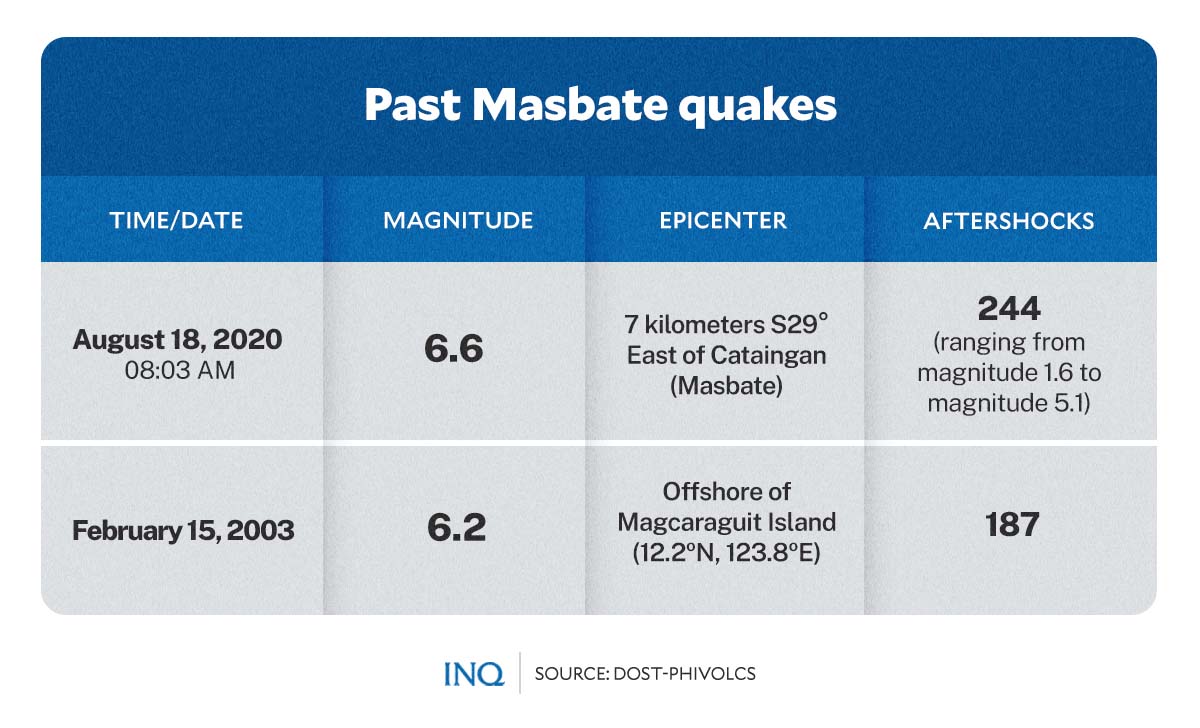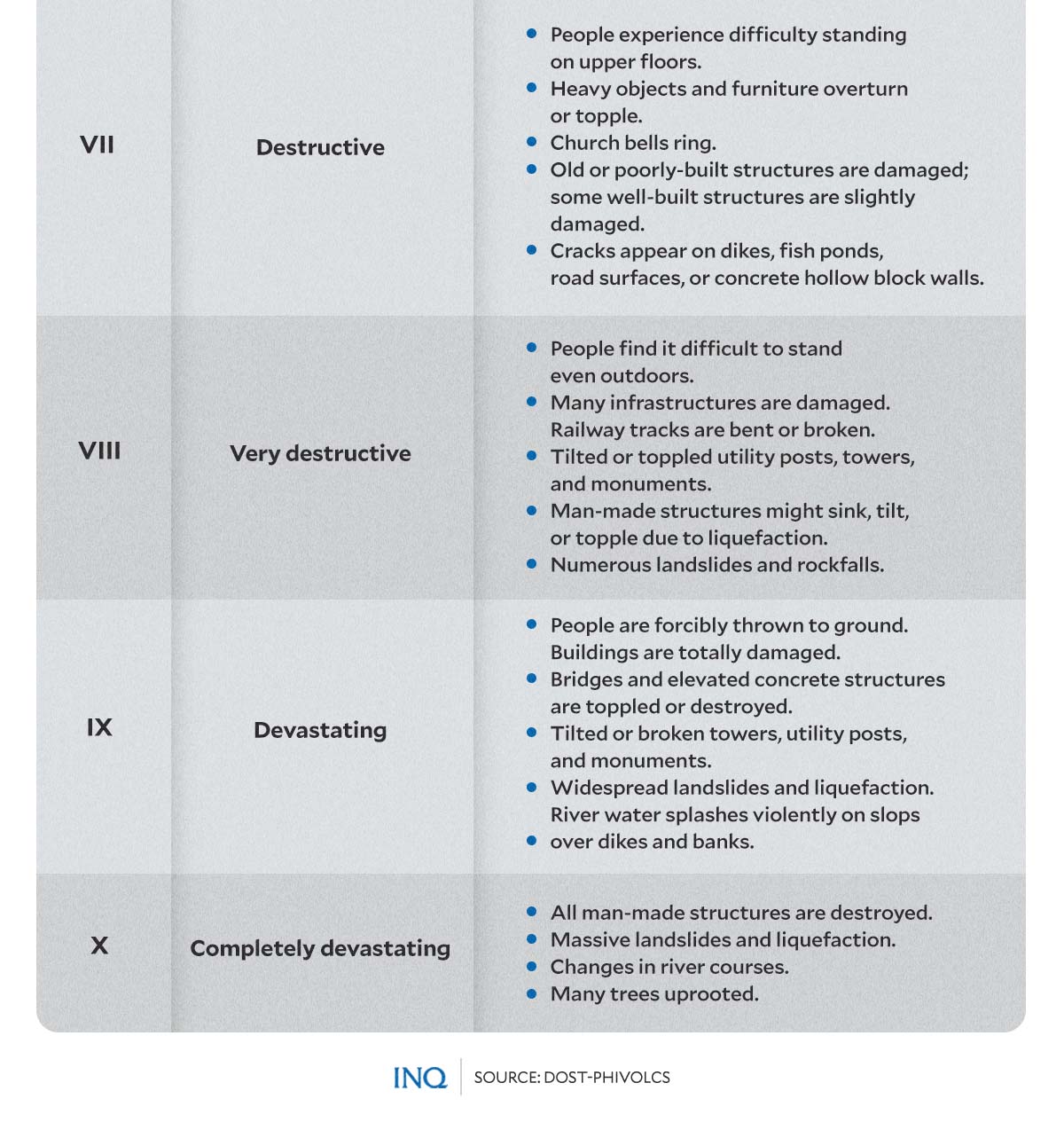Strong earthquakes in Masbate: What do they tell us?
MANILA, Philippines—Over two years since a strong earthquake rocked Masbate, considered to be earthquake-prone, several parts of the province have been yet again struck by a huge temblor early on Thursday (Feb. 16).
Around 2:10 a.m., residents in areas surrounding the municipality of Butuan were awakened by a magnitude 6.0 earthquake, which was followed by several aftershocks, causing some people to feel uneasy.
The earthquake occurred hours after another earthquake was recorded in a different municipality in Masbate and years after two major seismic events devastated the province.
Twin earthquakes in Batuan, Dimasalang
According to data from the Philippine Institute of Volcanology and Seismology (Phivolcs), the epicenter of the magnitude 6.0 tectonic earthquake was located 10 km southwest of Batuan and had a depth of 10 km.
The reported intensities were:
- Intensity 7– Masbate City in Masbate
- Intensity 5 – Dimasalang in San Fernando and Uson in Masbate
- Intensity 4– Legazpi in Albay; Aroroy, Cataingan, Esperanza, Milagros, and Pio V. Corpuz in Masbate; Irosin and Sorsogon City in Sorsogon
- Intensity 3– Daraga in Albay
The following instrumental, or related, intensities were also felt in the following areas:
- Intensity 6– Masbate City in Masbate
- Intensity 4 – Bulusan and Sorsogon City in Sorsogon; Bogo City in Cebu
- Intensity 3– Legazpi City and Tabaco City in Albay; Iriga City in Camarines Sur; Bago City in Negros Occidental; Alangalang, Calubian, Isabel, Kananga, and Palo in Leyte; Ormoc City and Rosario in Northern Samar
- Intensity 2 – Gumaca in Quezon; Daet in Camarines Norte; Ragay in Camarines Sur; Prieto Diaz in Sorsogon; Malinao, in Aklan; Jamindan and Tapaz in Capiz; Argao in Cebu; Can-Avid in Eastern Samar; Abuyog and Dulag in Leyte; San Roque in Northern Samar
- Intensity 1– Lopez, Mulanay, and Polillo in Quezon; Boac in Marinduque; Pandan in Antique; La Carlota City in Negros Occidental; Saint Bernard in Southern Leyte
READ: Magnitude 6.0 earthquake recorded off Masbate
Phivolcs noted that the earthquake was expected to cause damage and aftershocks. As of 7:00 a.m., there has been no significant damage reported to the Office of Civil Defense (OCD), according to OCD spokesperson Raffy Alejandro.
Several aftershocks have been recorded by Phivolcs, including magnitude 4.1 and magnitude 4.2 tremors minutes after the magnitude 6.0 quake, with both epicenters located in Batuan.
Prior to the Batuan quake, a magnitude 5.0 tectonic quake was felt in the municipality of Dimasalang around 5:15 p.m. on Wednesday, February 15.
Intensity 6 was felt in the City of Masbate, while other areas reported the following intensities:
- Intensity 5- Uson, Masbate
- Intensity 4- Aroroy, Batuan, Dimasalang, Mobo, San Fernando, and San Jacinto, Masbate
- Intensity 3- City of Legazpi and Daraga, Albay; Baleno, Cataingan, Claveria, Milagros, Monreal, and Palanas, Masbate; Irosin, Sorsogon; Capul, Catarman, and San Vicente, Northern Samar
- Intensity 2 – Guinobatan, Albay; Pio V. Corpuz, and Placer, Masbate; City of Sorsogon, and Bulusan, Sorsogon; City of Roxas, Capiz; Allen, Rosario, San Isidro, and Victoria, Northern Samar
- Intensity I – City of Ligao, Albay; Bobon, Northern Samar
Phivolcs also recorded the following instrumental intensities:
- Intensity 5- City of Masbate, Masbate
- Intensity 3 – City of Legazpi, Albay
- Intensity 2 – City of Tabaco, Albay; City of Iriga, and Pasacao, Camarines Sur; City of Sorsogon, and Bulusan, Sorsogon; Rosario, Northern Samar
- Intensity 1- Gumaca, Quezon
Why earthquakes frequently occur in Masbate
In a radio interview, Phivolcs Director Teresito Bacolcol explained that both earthquakes that hit Masbate were caused by the movement of the Philippine Fault Zone—the 1,200-kilometer-long major tectonic feature that transects the entire Philippine archipelago from northwestern Luzon to southeastern Mindanao.
This arc-parallel, left-lateral strike-slip fault is divided into several segments, including one that is located in Masbate province called the Masbate Fault—which, according to Phivolcs, is highly active.
Two potentially active faults are also located in the province: Uson Fault and the Southern Masbate Fault. These faults, according to Phivolcs, make Masbate one of the most seismically active regions in the country.
“There are other nearby local faults, some of which may be covered by recent deposits, and offshore active faults that could be sources of minor to strong earthquakes,” Phivolcs said.
Based on historical data, Phivolcs explained that the return period of large magnitude earthquakes along the Masbate Segment of the Philippine Fault Zone could be as short as five years or as long as thirty years with an average of about 10 years.
It added that large earthquakes along the Masbate Fault usually have magnitudes ranging from 6.0 to 7.0.
“Furthermore, it is very notable that even earthquakes with less than Ms 6.0 produced ground rupture along the Masbate Segment and caused significant damages near and along the location of the Masbate Segment,” Phivolcs said.
Past powerful earthquakes
Aside from the recent earthquake in Batuan, two other strong earthquakes in Masbate were also caused by the movement of the Masbate Fault, according to Phivolcs.
On February 15, 2003, a magnitude 6.2 earthquake struck the province at 7.01 p.m. Phivolc’s preliminary determination of epicenter indicated that the event was generated along the Masbate Segment of the Philippine Fault Zone.
Initial reports noted that the earthquake was felt all over the island of Masbate, including the nearby region of Bicol and the provinces of Leyte, Panay, Cebu, Negros, and Romblon. At least 187 aftershocks were recorded.
A magnitude 6.6 earthquake shook the province of Masbate and its vicinity in the morning of August 18 in 2020. According to then-Phivolcs chief Renato Solidum, the epicenter of the quake in Cataingan had been moving days prior to that quake.
READ: Magnitude 6.6 quake in Masbate caused by movement of PH fault zone – Phivolcs
There were at least 244 aftershocks recorded, with magnitudes ranging from 1.6 to 5.1. Two died, and 170 individuals were injured in the 2020 Masbate earthquake.
READ: Masbate earthquake: They saw it coming
Data from Phivolcs showed that historical earthquakes along the Masbate Segment of the Philippine Fault Zone date back to the year 1800s. Among the strongest earthquakes that have hit the province were:
- Magnitude 6.6 in 1915
- Magnitude 6.3 in 1970 and 1971
- Magnitude 5.7 on May 07, 1998, which was felt at intensity 6vall over the City of Masbate and the municipalities of Mobo and Uson
- Magnitude 5.1 on May 07, 1998, with reported intensity 6 in Masbate City
RELATED STORIES:
Earthquake preparedness saves lives: What to do
Dying in an earthquake: Experts say it’s not just the tremor
LIST: Killer earthquakes in the Philippines





